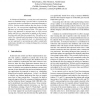Free Online Productivity Tools
i2Speak
i2Symbol
i2OCR
iTex2Img
iWeb2Print
iWeb2Shot
i2Type
iPdf2Split
iPdf2Merge
i2Bopomofo
i2Arabic
i2Style
i2Image
i2PDF
iLatex2Rtf
Sci2ools
TIME
2003
IEEE
2003
IEEE
A Novel Approach to Model NOW in Temporal Databases
In bitemporal databases, current facts and transaction states are modelled using a special value to represent the current time (such as a minimum or maximum timestamp or NULL). Previous studies indicate that the choice of value for now (i.e. the current time) significantly influences the efficiency of accessing bitemporal data. This paper introduces a new approach to represent now, in which current tuples and facts are represented as points on the transaction time and valid time line respectively. This allows us to exploit the computational advantages of point-based query languages. Via an empirical study, we demonstrate that our new approach to representing now offers considerable performance benefits over existing techniques for accessing bitemporal data.
| Added | 05 Jul 2010 |
| Updated | 05 Jul 2010 |
| Type | Conference |
| Year | 2003 |
| Where | TIME |
| Authors | Bela Stantic, John Thornton, Abdul Sattar |
Comments (0)

